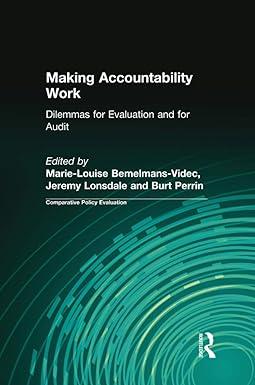Question
Alison and Chuck Renny began operations of their furniture repair shop (Lazy Sofa Furniture, Inc.) on January 1, 2017. The annual reporting period ends December
Alison and Chuck Renny began operations of their furniture repair shop (Lazy Sofa Furniture, Inc.) on January 1, 2017. The annual reporting period ends December 31. The trial balance on January 1, 2018, follows (amounts are rounded to thousands of dollars to simplify).
| Account Titles | Debit | Credit | |||||
| Cash | $ | 4 | |||||
| Accounts Receivable | 5 | ||||||
| Supplies | 1 | ||||||
| Equipment | 7 | ||||||
| Accumulated Depreciation | $ | 0 | |||||
| Software | 11 | ||||||
| Accumulated Amortization | 5 | ||||||
| Accounts Payable | 8 | ||||||
| Notes Payable (long-term) | 0 | ||||||
| Salaries and Wages Payable | 0 | ||||||
| Interest Payable | 0 | ||||||
| Income Tax Payable | 0 | ||||||
| Deferred Revenue | 0 | ||||||
| Common Stock | 10 | ||||||
| Retained Earnings | 5 | ||||||
| Service Revenue | 0 | ||||||
| Supplies Expense | 0 | ||||||
| Depreciation Expense | 0 | ||||||
| Salaries and Wages Expense | 0 | ||||||
| Amortization Expense | 0 | ||||||
| Interest Expense | 0 | ||||||
| Income Tax Expense | 0 | ||||||
| Totals | $ | 28 | $ | 28 | |||
Transactions during 2018 (summarized in thousands of dollars) follow:
- Borrowed $14 cash on July 1, 2018, signing a six-month note payable.
- Purchased equipment for $16 cash on July 2.
- Issued additional shares of common stock on July 3 for $6.
- Purchased additional equipment on August 4, $2 cash.
- Purchased, on account, supplies on September 5 for future use, $8.
- On December 6, recorded revenues in the amount of $56, including $7 on credit and $49 received in cash.
- Paid salaries and wages expenses on December 7, $26.
- Collected accounts receivable on December 8, $9.
- Paid accounts payable on December 9, $12.
- Received a $5 deposit on December 10 for work to start January 15, 2019.
Data for adjusting journal entries on December 31:
- Amortization for 2018, $5.
- Supplies of $6 were counted on December 31, 2018.
- Depreciation for 2018, $3.
- Accrued interest on notes payable of $1.
- Wages earned but not yet paid, $4.
- Income tax for 2018 was $6 and will be paid in 2019.
Required:
- Record journal entries for transactions (a) through (j). (If no entry is required for a transaction/event, select "No Journal Entry Required" in the first account field. Enter your answers in thousands of dollars.)
-
1, 3, 5 and 8. Set up T-accounts for the accounts on the trial balance. Enter beginning balances and post the transactions a-j, adjusting entries k-p, and closing entry. (Enter your answers in thousands of dollars.)
- Prepare an unadjusted trial balance. (Enter your answers in thousands of dollars.)
- Record adjusting journal entries (k) through (p). (If no entry is required for a transaction/event, select "No journal entry required" in the first account field. Enter your answers in thousands of dollars.)
- Post the adjusting entries from requirement 4 and prepare an adjusted trial balance. (Enter your answers in thousands of dollars.)
-
Step by Step Solution
There are 3 Steps involved in it
Step: 1

Get Instant Access to Expert-Tailored Solutions
See step-by-step solutions with expert insights and AI powered tools for academic success
Step: 2

Step: 3

Ace Your Homework with AI
Get the answers you need in no time with our AI-driven, step-by-step assistance
Get Started


